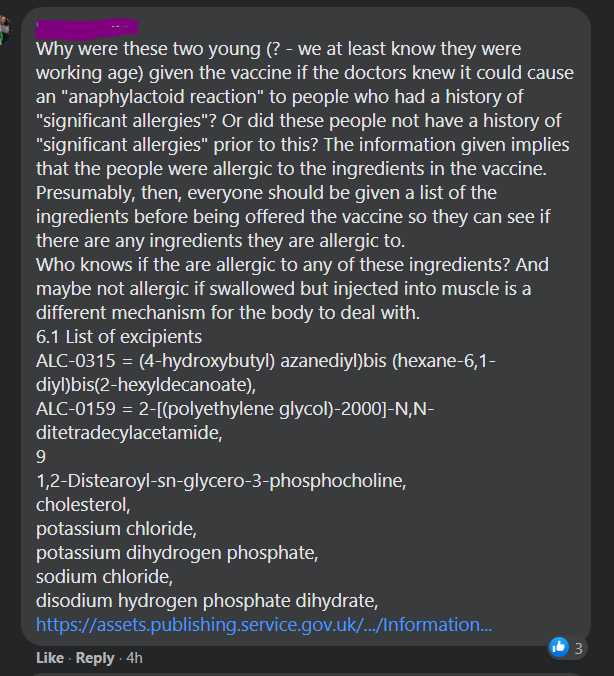A year ago I posted an explanation on vaccine “ingredients”, in relation to some wild claims made about the measles vaccine in the context of Samoa’s measles epidemic. From what I’ve seen on recent RNZ comments threads, an update for the time of SARS-Cov-2 is required.
So, here’s purple making a statement about the Pfizer covid-19 vaccine that – in the context of the thread where it was posted – seems intended to sow fear, doubt & uncertainty.

Apart from the fact that the information in the actual article doesn’t make this implication, but does say the people involved had a history of severe allergic reactions, should we really worry about the list of chemicals contained in each vial of the vaccine? There’s some complex chemical names in it! (Purple omitted the sucrose that’s also an item on the list.)
Like the first two chemicals on the list (ALC-0315 & ALC-0159), 1,2-Distearoyl-sn-glycero-3-phosphocholine is a lipid molecule. In fact, it’s cholesterol, a molecule that’s an essential part of cell membranes. Together they’re used to form the tiny lipid ‘bubbles’ (aka liposomes¹) that are used to enclose the vaccine’s active ingredient (the mRNA² coding for SARS-Cov-2’s spike protein) and allow it to move into cells. As the primary ingredient (apart from that mRNA) ALC-0315 there to ‘hold’ the mRNA. (This same technology has been trialled for use in delivery of chemotherapy agents for some cancers.)
Potassium chloride & sodium chloride (table salt) are molecules that are important in normal tissue metabolism, including the maintenance of an electrical potential difference across cell membranes (your cells won’t work without it) and the generation of nerve impulses. The few tens of micrograms in any given vaccine are swamped by the amount normally found in your body: someone weighing 50kg will have about 200g of sodium chloride in their tissues, for example.
Potassium dihydrogen phosphate is also found in the body (it may also be used to treat people with low levels of phosphate). It’s what’s known as a buffer, and the ions it’s comprised of – potassium & phosphate – are both required for your metabolism to work properly. In vaccines, this compound maintains the correct pH balance and also helps keep the active ingredient (in the case of the Pfizer covid-19 vaccine, the lipid bubbles containing mRNA) suspended evenly in water. Disodium hydrogen phosphate dihydrate (aka disodium phosphate) is also a pH buffer.
In combination those four salts are called phosphate-buffered saline (PBS), which ensures that the vaccine pH is close to that of human cells.
And the sucrose? It’s a cryoprotectant – remember that this vaccine has to be stored at -80°C, and the sugar protects the liposomes at these very low temperatures.
With the exception of the first two lipids, these are all compounds that occur in our bodies & in fact are important players in normal cellular properties & functions. So purple is drawing a very long bow indeed in suggesting that we might be allergic to them.
The first two lipids? Yes, it’s possible that they may cause allergic reactions, and that is why the vaccine is delivered in medical premises and why patients are asked to remain after receiving it, so that they can be monitored. However, from reading the documents that Pfizer-BioNTech provided to the FDA when seeking approval for the vaccine, it appears that there were no severe allergenic (aka anaphylactic) events in the trial participants. (It’s also clear from the document that the company has committed to long-term monitoring of both the original trial participants and of those receiving its vaccine once it’s approved by various governments.)
¹ A friend has pointed out that strictly speaking, these aren’t liposomes, because while there’s an ordered layer of lipid molecules on the outside, the inside is a jumble of more liposomes & embedded mRNA.
² There’s an excellent article about how mRNA vaccines work here at The Conversation. And if you’re on social media, Your Friendly Neighbourhood Epidemiologist has a very good explainer of the documents submitted to the FDA, & of that institution’s approval process.
Oh, & the healthcare workers in the original article may not have been all that young – the average age of UK healthcare workers is in the mid-forties, with many working into their 60s and some beyond that.

Moz says:
They left dihydrogen monoxide, hydrogen hydroxide, and oxygen dihydride off the list. What’s the world coming to when even the antiscientists can’t get the basics right? Was that post even peer reviewed?
Thanks for the breakdown, you saved me even having to think about it 🙂
Alison says:
Yes, they missed a real opportunity to sow even more FUD, didn’t they? 😀